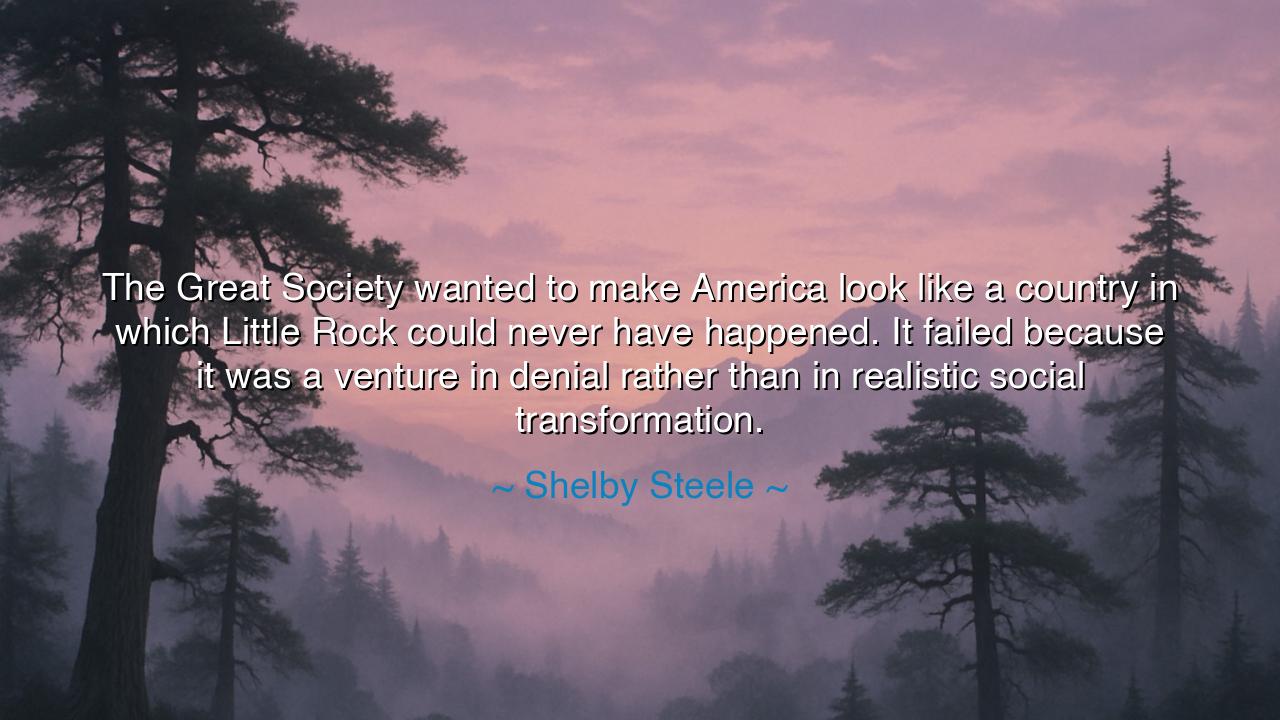
The Great Society wanted to make America look like a country in
The Great Society wanted to make America look like a country in which Little Rock could never have happened. It failed because it was a venture in denial rather than in realistic social transformation.






Hear the piercing words of Shelby Steele, spoken with the weight of history upon them: “The Great Society wanted to make America look like a country in which Little Rock could never have happened. It failed because it was a venture in denial rather than in realistic social transformation.” These words cut to the marrow, for they speak of the gulf between appearances and truth. Steele tells us that the Great Society, though noble in its intentions, sought to cloak America in the garments of justice without first mending the wounds of injustice. To erase the memory of Little Rock—that city where children were spat upon and soldiers had to escort them into school—America sought symbols of progress, but symbols without the substance of true transformation cannot endure.
The origin of this thought lies in Steele’s reflections on the civil rights era and its aftermath. The Great Society, launched by President Lyndon B. Johnson in the 1960s, sought to eliminate poverty and racial injustice through government programs. Yet Steele argues that instead of addressing the deep roots of racism, segregation, and inequality, these efforts often worked as a kind of denial—a way of saying “we are not that country” without changing the structures that produced Little Rock in the first place. His critique is not that compassion was misguided, but that the medicine was superficial, addressing appearance rather than essence.
The ancients, too, spoke of this danger. Plato warned against the semblance of justice without its reality, likening it to shadows upon the cave wall. To paint a city’s exterior white while its foundations rot is folly, for when the storm comes, the house will fall. So too with nations: to deny the past without transforming the present is to build illusions. Steele’s words are a reminder that denial masquerades as healing, yet true healing requires depth, patience, and sacrifice.
History gives us the very story of Little Rock, 1957, when nine Black students dared to enter Central High School under the protection of federal troops. Their courage revealed the raw hatred and violence that lay within the heart of America. The Great Society sought to erase such memories, to declare that the nation had moved beyond them. Yet hatred cannot be erased by proclamation. Inequality cannot be washed away by slogans. The spirit of Little Rock lingered in segregated neighborhoods, underfunded schools, and quiet discrimination. The attempt to deny its presence only deepened the wound.
The meaning of Steele’s words, then, is both somber and instructive: that progress built upon denial is fragile and hollow. Real transformation requires more than laws, more than programs—it requires a reckoning with the past, a reshaping of the heart, and the courage to face uncomfortable truths. Without such honesty, even the most ambitious projects crumble under the weight of unacknowledged reality. Denial, though dressed in noble garments, is no substitute for justice.
What lesson, then, must we draw from this? That societies cannot heal by pretending they are already whole. A nation must face its own Little Rocks—its failures, its cruelties, its shame—with humility. Only then can change be built upon solid ground. We must teach truth, not myths, to our children. We must build institutions that do not merely mask inequality, but dismantle it. And we must cultivate a spirit that values honesty over appearances, for only truth transforms.
Therefore, children of the future, engrave this wisdom upon your hearts: denial is the enemy of transformation. Do not seek to look good; seek to be good. Do not whitewash injustice; confront it with courage. For only when a society dares to face its darkest moments can it rise into the light. Let the memory of Little Rock be not a shame to be hidden, but a lesson to be learned—a reminder that progress is not in appearances, but in the patient labor of true and lasting change.






AAdministratorAdministrator
Welcome, honored guests. Please leave a comment, we will respond soon